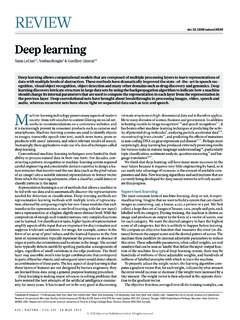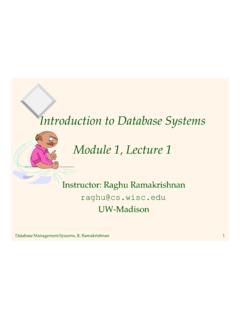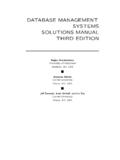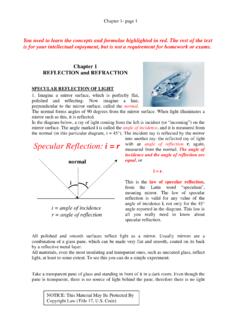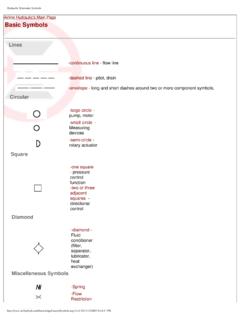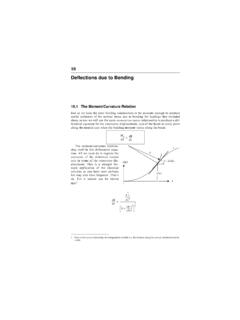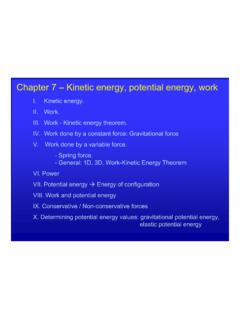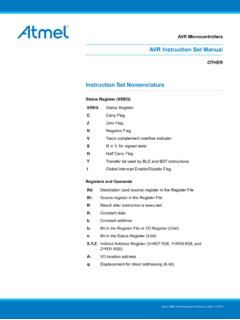Transcription of Machine Learning: Decision Trees - University of Wisconsin ...
1 Machine Learning: Decision Trees CS540 Jerry Zhu University of Wisconsin -Madison [ Some slides from Andrew Moore ~awm/tutorials and Chuck Dyer, with permission.] x The input These names are the same: example, point, instance, item, input Usually represented by a feature vector These names are the same: attribute, feature For Decision Trees , we will especially focus on discrete features (though continuous features are possible, see end of slides) Example: mushrooms Mushroom features : bell=b,conical=c,convex=x,flat=f, knobbed=k,sunken=s : fibrous=f,grooves=g,scaly=y,smooth=s : brown=n,buff=b,cinnamon=c,gray=g,green=r , pink=p,purple=u,red=e,white=w,yellow=y : bruises=t,no=f : almond=a,anise=l,creosote=c,fishy=y,foul =f, musty=m,none=n,pungent=p,spicy=s : attached=a,descending=d,free=f,notched=n y The output These names are the same.
2 Label, target, goal It can be Continuous, as in our population prediction Regression Discrete, , is this mushroom x edible or poisonous? Classification Two mushrooms x1=x,s,n,t,p,f,c,n,k,e,e,s,s,w,w,p,w,o,p ,k,s,u y1=p x2=x,s,y,t,a,f,c,b,k,e,c,s,s,w,w,p,w,o,p ,n,n,g y2=e : bell=b,conical=c,convex=x,flat=f, knobbed=k,sunken=s : fibrous=f,grooves=g,scaly=y,smooth=s : brown=n,buff=b,cinnamon=c,gray=g,green=r , pink=p,purple=u,red=e,white=w,yellow=y Supervised Learning Training set: n pairs of example, label: (x1,y1)..(xn,yn) A predictor ( , hypothesis: classifier, regression function) f: x y Hypothesis space: space of predictors, , the set of d-th order polynomials. Find the best function in the hypothesis space that generalizes well. Performance measure: MSE for regression, accuracy or error rate for classification Evaluating classifiers During training Train a classifier from a training set (x1,y1), (x2,y2).
3 , (xn,yn). During testing For new test data xn+ +m, your classifier generates predicted labels y n+ y n+m Test set accuracy: You need to know the true test labels yn+ yn+m Test set accuracy: Test set error rate = 1 acc mnniyyiimacc1'11 Decision Trees One kind of classifier (supervised learning) Outline: The tree Algorithm Mutual information of questions Overfitting and Pruning Extensions: real-valued features, tree rules, pro/con A Decision Tree A Decision tree has 2 kinds of nodes leaf node has a class label, determined by majority vote of training examples reaching that leaf. internal node is a question on features. It branches out according to the answers. Automobile Miles-per-gallon prediction mpgcylindersdisplacementhorsepowerweight accelerationmodelyearmakergood4lowlowlow high75to78asiabad6mediummediummediummedi um70to74americabad4mediummediummediumlow 75to78europebad8highhighhighlow70to74ame ricabad6mediummediummediummedium70to74am ericabad4lowmediumlowmedium70to74asiabad 4lowmediumlowlow70to74asiabad8highhighhi ghlow75to78america.
4 Bad8highhighhighlow70to74americagood8hig hmediumhighhigh79to83americabad8highhigh highlow75to78americagood4lowlowlowlow79t o83americabad6mediummediummediumhigh75to 78americagood4mediumlowlowlow79to83ameri cagood4lowlowmediumhigh79to83americabad8 highhighhighlow70to74americagood4lowmedi umlowmedium75to78europebad5mediummediumm ediummedium75to78europeA very small Decision tree Internal node question: what is the number of cylinders ? Leaves: classify by majority vote A bigger Decision tree question: what is the value of maker ? question: what is the value of horsepower ? 1. Do not split when all examples have the same label 2. Can not split when we run out of questions The full Decision tree Decision tree algorithm buildtree(examples, questions, default) /* examples: a list of training examples questions: a set of candidate questions, , what s the value of feature xi?
5 Default: default label prediction, , over-all majority vote */ IF empty(examples) THEN return(default) IF (examples have same label y) THEN return(y) IF empty(questions) THEN return(majority vote in examples) q = best_question(examples, questions) Let there be n answers to q Create and return an internal node with n children The ith child is built by calling buildtree({example|q=ith answer}, questions\{q}, default) The best question What do we want: pure leaf nodes, all examples having (almost) the same y. A good question a split that results in pure child nodes How do we measure the degree of purity induced by a question? Here s one possibility (Max-Gain in book): mutual information ( information gain) A quantity from information theory Entropy At the current node, there are n=n1+.
6 +nk examples n1 examples have label y1 n2 examples have label y2 .. nk examples have label yk What s the impurity of the node? Turn it into a game: if I put these examples in a bag, and grab one at random, what is the probability the example has label yi? Entropy Probability estimated from samples: with probability p1=n1/n the example has label y1 with probability p2=n2/n the example has label y2 .. with probability pk=nk/n the example has label yk p1+p2+..+pk=1 The outcome of the draw is a random variable y with probability (p1, p2, .., pk) What s the impurity of the node what s the uncertainty of y in a random drawing? Entropy Interpretation: The number of yes/no questions (bits) needed on average to pin down the value of y in a random drawing H(y)= H(y)= H(y)= kiiikiiippyYyYYH1212log)Pr(log)Pr()(Entr opy p(head)= p(tail)= H=1 p(head)= p(tail)= H= biased coin p(head)=?
7 P(tail)=? H=? Jerry s coin Conditional entropy Y: label. X: a question ( , a feature). v: an answer to the question Pr(Y|X=v): conditional probability XvkiiivXYHvXXYHvXyYvXyYvXYH of values:12)|()Pr()|()|Pr(log)|Pr()|(Infor mation gain Information gain, or mutual information Choose question (feature) X which maximizes I(Y;X). )|()();(XYHYHXYI Example Features: color, shape, size What s the best question at root? + - The training set Example Color Shape Size Class 1 Red Square Big + 2 Blue Square Big + 3 Red Circle Big + 4 Red Circle Small - 5 Green Square Small - 6 Green Square Big - H(class)= H(class | color)= green is - blue is + Example Color Shape Size Class 1 Red Square Big + 2 Blue Square Big + 3 Red Circle Big + 4 Red Circle Small - 5 Green Square Small - 6 Green Square Big - H(class)= H(3/6,3/6) = 1 H(class | color)= 3/6 * H(2/3,1/3) + 1/6 * H(1,0) + 2/6 * H(0,1) 3 out of 6 are red 1 out of 6 is blue 2 out of 6 are green 2 of the red are + Example Color Shape Size Class 1 Red Square Big + 2 Blue Square Big + 3 Red Circle Big + 4 Red Circle Small - 5 Green Square Small - 6 Green Square Big - H(class)= H(3/6,3/6) = 1 H(class | color)= 3/6 * H(2/3,1/3)
8 + 1/6 * H(1,0) + 2/6 * H(0,1) I(class; color) = H(class) H(class | color) = bits Example Color Shape Size Class 1 Red Square Big + 2 Blue Square Big + 3 Red Circle Big + 4 Red Circle Small - 5 Green Square Small - 6 Green Square Big - H(class)= H(3/6,3/6) = 1 H(class | shape)= 4/6 * H(1/2, 1/2) + 2/6 * H(1/2,1/2) I(class; shape) = H(class) H(class | shape) = 0 bits Shape tells us nothing about the class! Example Color Shape Size Class 1 Red Square Big + 2 Blue Square Big + 3 Red Circle Big + 4 Red Circle Small - 5 Green Square Small - 6 Green Square Big - H(class)= H(3/6,3/6) = 1 H(class | size)= 4/6 * H(3/4, 1/4) + 2/6 * H(0,1) I(class; size) = H(class) H(class | size) = bits Example Color Shape Size Class 1 Red Square Big + 2 Blue Square Big + 3 Red Circle Big + 4 Red Circle Small - 5 Green Square Small - 6 Green Square Big - I(class; color) = H(class) H(class | color) = bits I(class; shape) = H(class) H(class | shape) = 0 bits I(class; size) = H(class) H(class | size) = bits We select color as the question at root Overfitting Example (regression): Predicting US Population We have some training data (n=11) What will the population be in 2020?
9 X=Year y=Million 1900 1910 1920 1930 1940 1950 1960 1970 1980 1990 2000 Regression: Polynomial fit The degree d (complexity of the model) is important Fit (=learn) coefficients cd, .. c0 to minimize Mean Squared Error (MSE) on training data Matlab demo: 0111)(cxcxcxcxfdddd niiixfynMSE12)(1 Overfitting As d increases, MSE on training data improves, but prediction outside training data worsens degree=0 MSE= degree=1 MSE= degree=2 MSE= degree=3 MSE= degree=4 MSE= degree=5 MSE= degree=6 MSE= degree=7 MSE= degree=8 MSE= degree=9 MSE= degree=10 MSE= Overfit a Decision tree a b c d e y 0 0 0 0 0 0 0 0 0 0 1 0 0 0 0 1 0 0 0 0 0 1 1 1 0 0 1 0 0 1.
10 1 1 1 1 1 1 Five inputs, all bits, are generated in all 32 possible combinations Output y = copy of e, Except a random 25% of the records have y set to the opposite of e 32 records Overfit a Decision tree The test set is constructed similarly y=e, but 25% the time we corrupt it by y= e The corruptions in training and test sets are independent The training and test sets are the same, except Some y s are corrupted in training, but not in test Some y s are corrupted in test, but not in training Overfit a Decision tree We build a full tree on the training set Root e=0 a=0 a=1 e=1 a=0 a=1 Training set accuracy = 100% 25% of these training leaf node labels will be corrupted ( e) Overfit a Decision tree And classify the test data with the tree Root e=0 a=0 a=1 e=1 a=0 a=1 25% of the test examples are corrupted independent of training data Overfit a Decision tree On average: training data uncorrupted of these are uncorrupted in test correct labels of these are corrupted in test wrong training data corrupted of these are uncorrupted in test wrong of these are also corrupted in test correct labels Test accuracy = * + * = 5/8 = Overfit a Decision tree But if we knew a,b,c,d are irrelevant features and don t use them in the a b c d e y 0 0 0 0 0 0 0 0 0 0 1 0 0 0 0 1 0 0 0 0 0 1 1 1 0 0 1 0 0 1.

